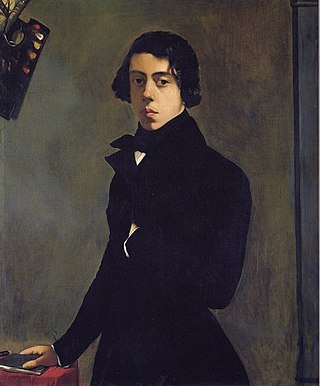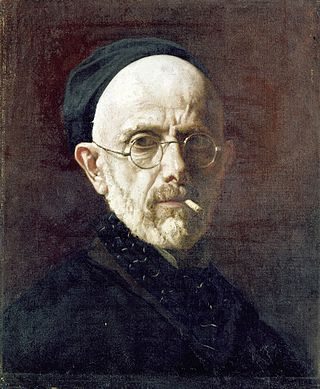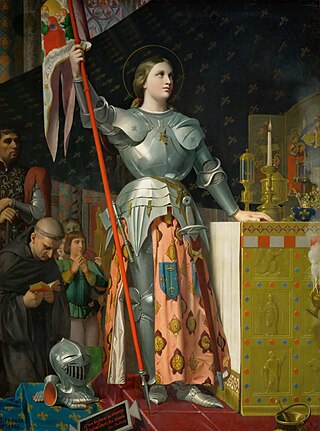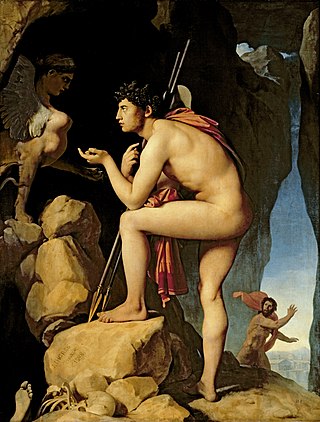
Jean-Auguste-Dominique Ingres was a French Neoclassical painter. Ingres was profoundly influenced by past artistic traditions and aspired to become the guardian of academic orthodoxy against the ascendant Romantic style. Although he considered himself a painter of history in the tradition of Nicolas Poussin and Jacques-Louis David, it is his portraits, both painted and drawn, that are recognized as his greatest legacy. His expressive distortions of form and space made him an important precursor of modern art, influencing Picasso, Matisse and other modernists.

Théodore Chassériau was a Dominican-born French Romantic painter noted for his portraits, historical and religious paintings, allegorical murals, and Orientalist images inspired by his travels to Algeria. Early in his career he painted in a Neoclassical style close to that of his teacher Jean-Auguste-Dominique Ingres, but in his later works he was strongly influenced by the Romantic style of Eugène Delacroix. He was a prolific draftsman, and made a suite of prints to illustrate Shakespeare's Othello. The portrait he painted at the age of 15 of Prosper Marilhat makes Chassériau the youngest painter exhibited at the Louvre museum.

Henri Lehmann was a German-born French historical painter and portraitist.

Pierre-Nolasque Bergeret was a French painter, pioneer lithographer and designer of medals and costumes for the stage, who studied with Jacques-Louis David.

Napoleon I on his Imperial Throne is an 1806 portrait of Napoleon I of France in his coronation costume, painted by the French painter Jean-Auguste-Dominique Ingres.

Odalisque with Slave is an 1839 painting by Jean-Auguste-Dominique Ingres commissioned by Charles Marcotte. Executed in oil on canvas, it depicts a nude odalisque, a musician, and a eunuch in a harem interior. The painting is in the Fogg Art Museum in Cambridge, Massachusetts. It is a classic piece of Orientalism in French painting.

Joan of Arc at the Coronation of Charles VII is an 1854 painting by Jean-Auguste-Dominique Ingres. It is now in the Louvre Museum in Paris.

The Dauphin's Entry Into Paris is an oil-on-canvas painting by Jean-Auguste-Dominique Ingres, executed in 1821. It is now in the Wadsworth Atheneum collection in Hartford, Connecticut.

The Sickness of Antiochus or Stratonice and Antiochus is an 1840 painting by the French artist Jean-Auguste-Dominique Ingres. It is now in the Musée Condé in Chantilly.

Roger Freeing Angelica or Ruggiero Freeing Angelica is an 1819 painting by the French artist Jean-Auguste-Dominique Ingres, inspired by Orlando Furioso by Ariosto. An oil painting on canvas measuring 147 x 199 cm, it is owned by the Louvre. Ingres subsequently painted several variants of the composition.

Oedipus and the Sphinx is a painting by the French Neoclassical artist Jean-Auguste-Dominique Ingres. Originally a student work painted in 1808, it was enlarged and completed in 1827. The painting depicts Oedipus explaining the riddle of the Sphinx. An oil painting on canvas, it measures 189 x 144 cm, and is in the Louvre, which acquired it in 1878.

Portrait of Madame de Senonnes is an 1816 painting by Jean-Auguste-Dominique Ingres. It shows Madame de Senonnes, née Marie-Genevieve-Marguerite Marcoz, viscountess of Senonnes (1783–1828). Marcoz was 31 when the portrait was completed. Ingres had earlier portrayed her in a drawing of 1813.

Portrait of Madame Duvaucey is an 1807 oil on canvas painting by Jean-Auguste-Dominique Ingres. It shows Antonia Duvauçey of Nittis, the lover of Charles-Jean-Marie Alquier, then ambassador to the Holy See. Duvaucey is positioned in a flat pictorial space, gazing frontally at the viewer, dressed in lavish clothing and accessories. The portrait is the first female portrait painted during the artist's stay in Rome. Portrait of Madame Duvaucey is acclaimed for exhibiting her enigmatic charm, and as "not a portrait that gives pleasure..[but]...a portrait that gives rise to dreams".

The Portrait of Comtesse d'Haussonville is an 1845 oil-on-canvas painting by the French Neoclassical artist Jean-Auguste-Dominique Ingres.

Portrait of Marie-Françoise Rivière is a c. 1805 oil-on-canvas painting by the French Neoclassical artist Jean-Auguste-Dominique Ingres.

Portrait of Madame Pastoret is a 1791 oil-on-canvas portrait by the French Neoclassical artist Jacques-Louis David. It depicts Adélaide Pastoret, née Piscatory de Vaufreland (1765–1843). David was a friend of the Pastoret family but broke with them in 1792 after he became more politically radical. With his portraits of Philippe-Laurent de Joubert and Madame Trudaine, it was one of three paintings left incomplete because of the advance of the French Revolution – all three figures were arrested or emigrated. An infant's head is also shown in the cot – this is Amédée de Pastoret, a future conseiller d'Etat, painted by Ingres in 1826.

Portrait of Madame Marcotte de Sainte-Marie is an 1826 painting by Jean-Auguste-Dominique Ingres of Suzanne Clarisse de Salvaing de Boissieu, wife of Marin Marcotte de Sainte-Marie. It is one of his earliest surviving portraits and one of the few portraits of women he produced in Paris straight after his return from Rome. Studies for it are now in the Louvre and a gallery in Montauban.

James-Alexandre de Pourtalès, Comte de Pourtalès-Gorgier was a Swiss-French banker, diplomat and art collector.

The Art Collection of James-Alexandre, comte de Pourtalès-Gorgier was a collection of sculpture, antiques and paintings owned by James-Alexandre de Pourtalès, Comte de Pourtalès-Gorgier until his death in 1855.

Luigi Cherubini and the Muse of Lyric Poetry is an 1842 oil-on-canvas allegorical portrait of Luigi Cherubini by Jean-Auguste-Dominique Ingres and his then-pupil Henri Lehmann. It was bought from Ingres for 8,000 francs by Louis-Philippe I using civil list money in June 1842 and given to the musée du Luxembourg, before being moved in 1874 to the Louvre Museum, in whose collections it still resides.




















